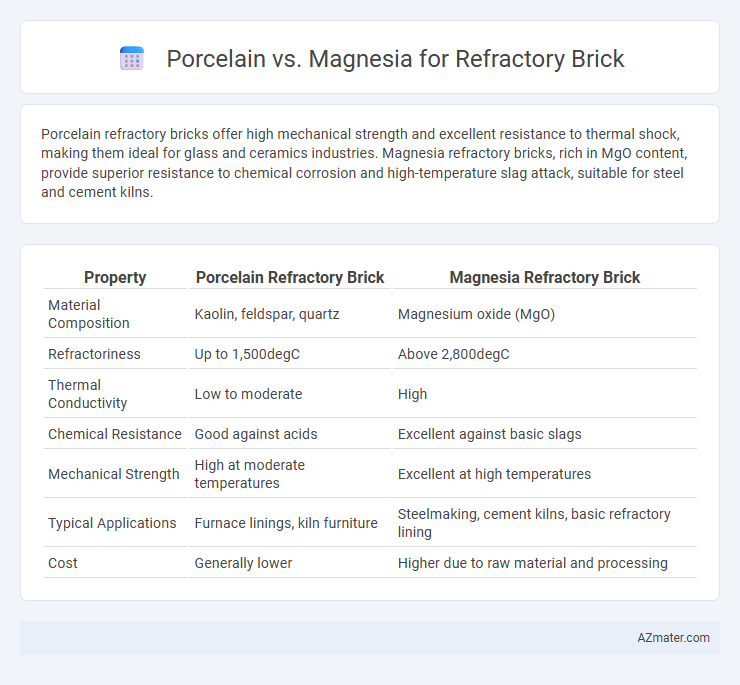Porcelain refractory bricks offer high mechanical strength and excellent resistance to thermal shock, making them ideal for glass and ceramics industries. Magnesia refractory bricks, rich in MgO content, provide superior resistance to chemical corrosion and high-temperature slag attack, suitable for steel and cement kilns.
Table of Comparison
| Property | Porcelain Refractory Brick | Magnesia Refractory Brick |
|---|---|---|
| Material Composition | Kaolin, feldspar, quartz | Magnesium oxide (MgO) |
| Refractoriness | Up to 1,500degC | Above 2,800degC |
| Thermal Conductivity | Low to moderate | High |
| Chemical Resistance | Good against acids | Excellent against basic slags |
| Mechanical Strength | High at moderate temperatures | Excellent at high temperatures |
| Typical Applications | Furnace linings, kiln furniture | Steelmaking, cement kilns, basic refractory lining |
| Cost | Generally lower | Higher due to raw material and processing |
Introduction to Refractory Bricks
Refractory bricks, essential for high-temperature industrial applications, must exhibit exceptional thermal stability and resistance to chemical attack. Porcelain refractory bricks are known for their excellent corrosion resistance and mechanical strength, making them suitable for environments with moderate heat exposure. Magnesia refractory bricks offer superior performance in extremely high-temperature settings due to their high melting point and excellent basicity, ideal for steel-making and kiln linings.
Overview of Porcelain Refractory Bricks
Porcelain refractory bricks are composed primarily of kaolin, feldspar, and quartz, offering excellent thermal stability and low thermal conductivity essential for high-temperature industrial applications. These bricks exhibit superior resistance to chemical corrosion, making them ideal for environments exposed to acidic slags and gases. Their dense microstructure ensures enhanced mechanical strength and durability compared to traditional magnesia bricks, which are more suited for alkaline environments.
Overview of Magnesia Refractory Bricks
Magnesia refractory bricks are primarily composed of magnesium oxide (MgO), offering high melting points above 2800degC and excellent resistance to basic slags, making them ideal for steelmaking furnaces and rotary kilns. These bricks feature strong thermal conductivity and superior corrosion resistance compared to porcelain bricks, which are mainly silica-based and suited for acidic environments. Their outstanding durability in harsh, high-temperature, and chemically aggressive settings ensures enhanced operational efficiency and longevity in industrial applications.
Material Composition and Properties
Porcelain refractory bricks are primarily composed of kaolin, silica, and feldspar, offering high mechanical strength and excellent thermal shock resistance suitable for moderate temperatures. Magnesia bricks consist mainly of magnesia (MgO), providing superior refractoriness and chemical resistance, especially against basic slags in high-temperature environments. The choice between porcelain and magnesia bricks depends on the thermal requirements and chemical exposure of the industrial application.
Thermal Resistance Comparison
Porcelain refractory bricks exhibit superior thermal resistance, withstanding temperatures up to 1,800degC, making them ideal for high-temperature industrial applications such as kilns and furnaces. Magnesia bricks, composed primarily of magnesium oxide, offer excellent thermal stability and resistance to basic slags, enduring temperatures around 2,000degC, which enhances their durability in steel-making environments. When comparing thermal resistance, magnesia bricks outperform porcelain in extreme temperature conditions, though porcelain bricks provide better mechanical strength and thermal shock resistance in moderate heat settings.
Chemical Stability and Corrosion Resistance
Porcelain refractory bricks exhibit high chemical stability due to their vitreous structure, which provides excellent resistance to acidic slags and chemical attack. Magnesia bricks, composed primarily of magnesium oxide, demonstrate superior corrosion resistance against basic slags and alkaline environments found in steelmaking processes. Both materials offer thermal stability, but magnesia bricks outperform porcelain in resisting chemical degradation under highly basic and corrosive conditions.
Mechanical Strength and Durability
Porcelain refractory bricks exhibit high mechanical strength due to their fine-grained, dense microstructure, which enhances resistance to abrasion and thermal shock. Magnesia refractory bricks, composed primarily of magnesium oxide, offer superior durability in high-temperature, basic slag environments because of their excellent chemical stability and corrosion resistance. While porcelain bricks provide excellent compressive strength, magnesia bricks are preferred for prolonged exposure to aggressive slags and thermal cycling in steelmaking industries.
Industrial Applications and Suitability
Porcelain refractory bricks offer excellent chemical resistance and thermal stability, making them ideal for industries like glass manufacturing and ceramics where high purity and corrosion resistance are critical. Magnesia refractory bricks provide superior slag resistance and high melting points, supporting steel production and cement kilns that demand robust performance under extreme temperatures. Choosing between these bricks depends on specific industrial needs such as chemical environment and thermal load for optimal durability and efficiency.
Cost Efficiency and Availability
Porcelain refractory bricks generally offer higher durability and lower thermal conductivity, but they come at a higher cost compared to magnesia bricks, which are more affordable and widely available due to abundant magnesite deposits. Magnesia refractory bricks provide excellent resistance to basic slags and high-temperature environments, making them cost-efficient for large-scale industrial applications despite their slightly lower lifespan. Availability of magnesia bricks is better in regions with extensive magnesite mining, improving supply chain reliability and reducing overall operational expenses.
Conclusion: Choosing Between Porcelain and Magnesia Bricks
Porcelain refractory bricks offer superior chemical resistance and thermal stability, making them ideal for environments with intense acid exposure and moderate temperatures. Magnesia bricks excel in high-temperature applications due to their excellent basicity and resistance to slag corrosion, particularly in steel-making furnaces. Selecting between porcelain and magnesia bricks depends on the specific furnace atmosphere and thermal requirements, with porcelain favored for acidic conditions and magnesia preferred for alkaline, high-temperature environments.

Infographic: Porcelain vs Magnesia for Refractory Brick
 azmater.com
azmater.com